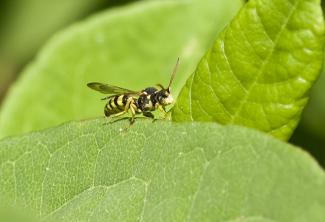
Image Credit: Cheryl Moorehead
Classic/Typical Cuckoo-Bees: (Anthophoridae: Nomadinae: many genera)
This group contains at least 8 genera documented from the Pacific Northwest, plus several more form the desert southwest. Most cuckoo-bees spend the majority of their activity searching for nest sites and NOT visiting flowers for nectar.
(A) the most abundant and diverse genus is Nomada (a parasite on spring bees (Andrena), and probably occasionally on the sweat bees (Halictidae) as well. Nomada has never been comprehensively studied and so it is not possible to identify individual species. They are abundantly seen searching all types of bare ground for nesting sites of Andrena (most subgenera) in the early spring and the late-summer (Andrena, subgenus Cnemidandrena). Species vary from nearly entirely yellow, to nearly entirely red, usually with a dark thorax. Some groups have males and females that closely resemble one another, other groups have very dissimilar sexual coloration. Nomada differs from the less diverse genera in this group by having a very long marginal cell.
(B) The rest of the typical cuckoo bees are tiny (1/8-1/3 inch; 3-9mm long), with much of the basolateral portions of the abdomen reddish, with prostrate white patterns of interrupted abdominal fasciae, and (of course) no pollen collecting apparatus. Most genera are very seldom observed and are poorly represented in museum insect collections. As a general rule, each genus of cuckoo-bees parasitizes the nests of a different genus of solitary bee.





Examples of the nearly infinite variety of color patterns of Nomada (no pictures of the yellow-bodied black-banded species).


Tiny kleptoparasitic bees of the genera Holcopasites (on the left; interrupted fasciae) and Neolarra (on the right; fasciate).